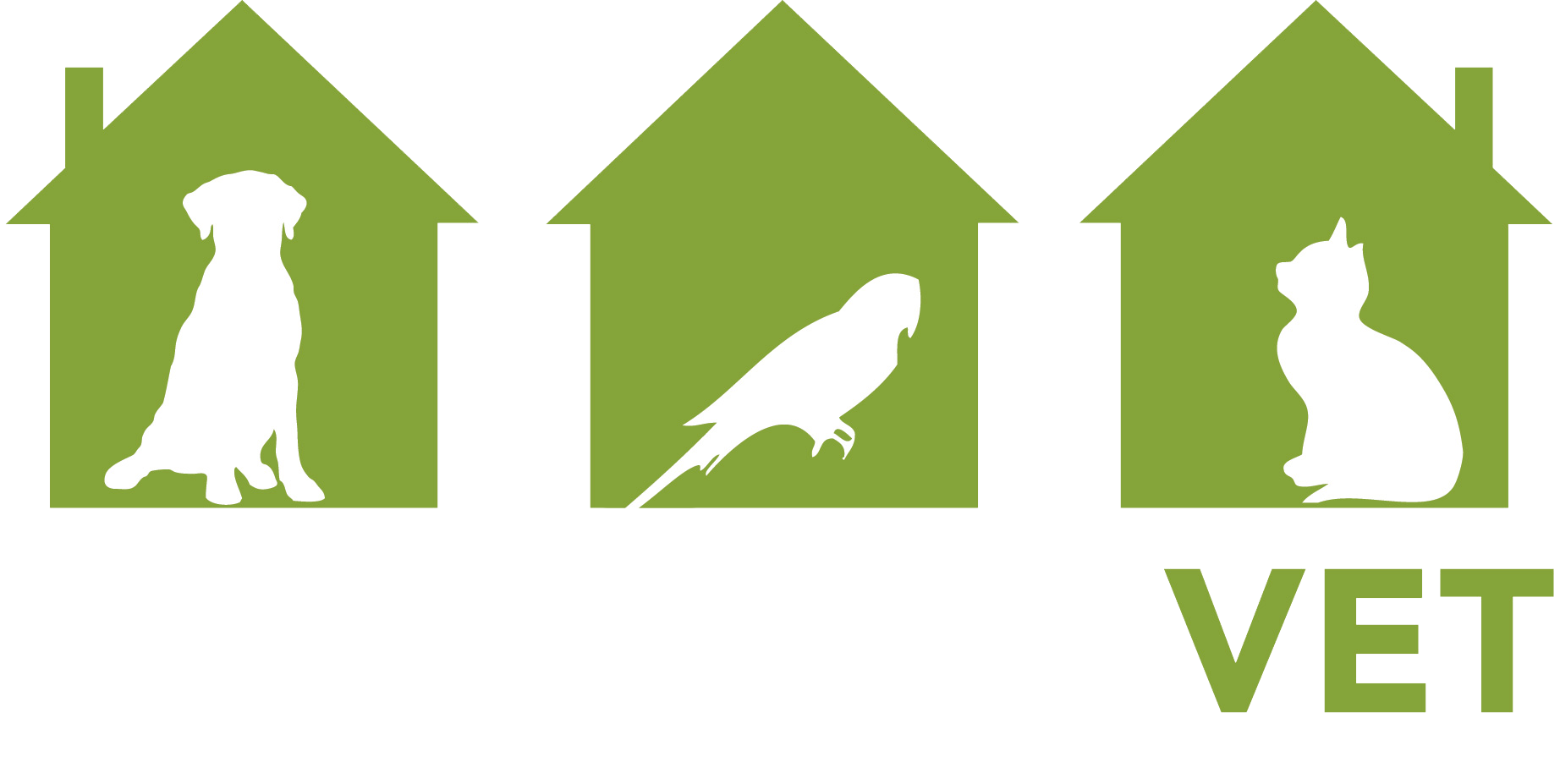Hearing the tap, tap, tap of your pup can bring instant joy to any animal lover’s heart! But as those delightful paws leave their mark, they also require regular attention and care. Among the most crucial aspects of pet grooming is the often-neglected task of nail maintenance. Whether you have a playful pup or older companion, proper nail care is essential for their comfort, mobility, and overall well-being.
At The House Call Vet, we understand the importance of regular nail trims and how learning to perform them with ease is vital to ensure your pet’s nails remain in excellent shape. Whether your dog is already comfortable with nail trims or needs a little extra paw-holding during the process, we’ve got you covered! In this latest post we discuss what you need to know about nail trimming to equip you with the essential knowledge and practical tips to conquer this often-dreaded aspect of pet care!
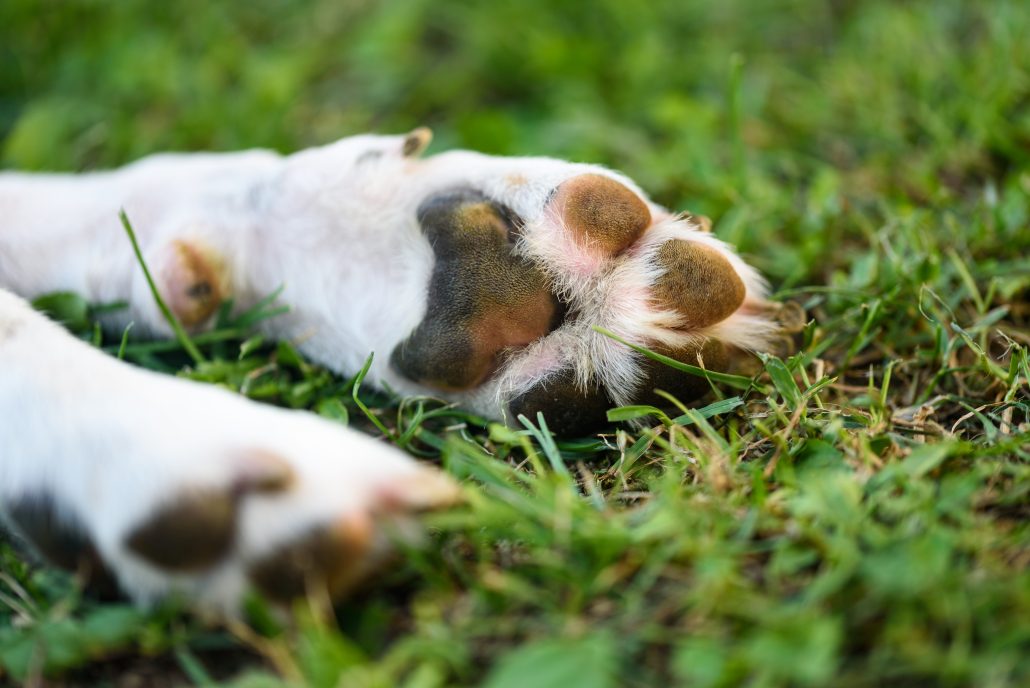
Why Regular Trimming & Maintenance is Important
Regular nail care for your furry friend extends far beyond mere cosmetic reasons. The natural growth pattern of a dog’s nails forms a distinct curved shape, and when left untrimmed, these long, unkempt nails can lead to a host of issues that can seriously impact your pup’s well-being.
- Enhanced Traction: Properly trimmed nails allow your dog to have better traction on various surfaces, making walks and playtime much safer and enjoyable.
- Healthy Feet: Overgrown nails can cause deformities in your dog’s feet, leading to discomfort and potential long-term issues.
- Avoiding Injuries: Long claws can curve under your dog’s paws and dig into the sensitive skin, causing pain and discomfort during movement. Additionally, if these injuries are left untreated, can also cause further pain and infections.
- Balanced Weight Distribution: When a dog’s nails are excessively long, they can put unnecessary pressure on the foot and leg structure. To compensate, your dog may shift more weight to their back or front paws, which can lead to sore muscles, joint problems, backaches, and even the development of arthritis over time.
- Protecting Surroundings: Longer nails can snag carpets, get caught on fabrics, and cause damage to furniture and flooring. Similarly, attempting to free a snagged nail may result in the outer enamel breaking away, exposing the sensitive quick, which increases the risk of injuries and infections.
- Safety for You: Untrimmed nails can be sharp and pose a risk of accidentally scratching you or other family members during play or interactions.
How Often Should You Trim Your Pet’s Nails?
For many dogs, our modern lifestyle means that their nails are not naturally worn down as quickly The level of physical activity and the type of surfaces your pup frequently encounters play a significant role in determining their nail maintenance needs.
If your dog spends ample time running or walking on pavements and concrete surfaces, they may naturally wear down their nails more effectively, with the exception of their dewclaws. On the other hand, pets that spend more time indoors or on softer surfaces like grass may require more regular nail trims.
It is important to remember that as the nails grows, so does the quick (the blood vessel and nerve inside the nail) which means that neglecting regular nail trims can lead to difficulties trimming nails without cutting into the quick. This can cause pain, bleeding, and potential infections, creating a distressing experience for your furry friend during nail trimming sessions.
Regardless of their lifestyle, it’s essential to regularly check your pet’s nails for signs of overgrowth. A good guideline to follow is If their nails touch the ground while standing, it’s time for a trim – this is generally one a month. Some other signs your pup needs a trim includes:
- You can hear them clicking on hard floors or the pavement
- There’s a long, slender curve coming off the nail
- The nail extends far past the quick
- Nails that are curving in on itself
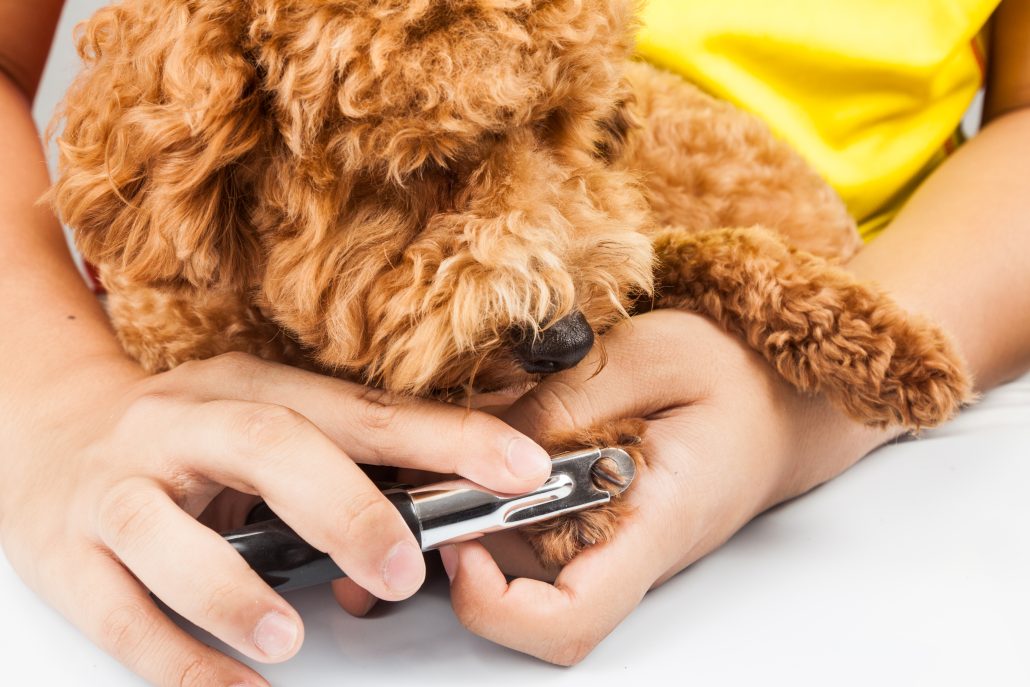
Getting Comfortable With Trims
Nail grooming for dogs are an often dreaded routine for many pet owners. While some dogs will happily sit on your lap and let you trim their claws, others may become anxious, fidgety, or even downright resistant at the sight of nail clippers!
If you’ve ever experienced the challenging task of trimming your pup’s nails, you’re not alone. Many pet parents find themselves in a nail-trimming struggle, unsure of how to make the process easier and less stressful for both themselves and their furry companions. Fortunately, with the right approach, patience, and lots of positive reinforcement, nail grooming can become a much more manageable and even enjoyable experience for your four-legged friend.
1. Start ASAP
No matter the age of your dog, introducing your furry friend to nail trimming as early as possible is a good step in helping them become comfortable with the process. Your first step should involve getting your furry friend used to having their feet, paw pads, and toes handled. Regularly touch and handle their paws during cuddle sessions or playtime to desensitize them to this sensation.
Next, gradually introduce your pup to the sight and sound of nail clippers and grinders. Making nail trimming a consistent part of their grooming routine will help them learn to associate it with positivity and reward, making the process less intimidating and more familiar as time passes.
2. Get The Right Tools
When it comes to nail trimming for your furry companion, investing in high-quality nail clippers or grinders designed specifically for dogs is an absolute must. These tools are essential for ensuring a safe and effective nail-trimming experience for both you and your pet.
Opt for clippers with sharp blades. Dull blades may crush the nails, causing discomfort and potential splintering. If you prefer using a grinder, choose one that provides smooth and controlled nail shaping. Grinders gently file down the nails, allowing for more precise and gradual trimming.
3. Cut Carefully
When it comes to nail trimming for your furry companion, caution is key. Approach the task with patience and care, trimming a small amount of nail at a time. Avoid cutting too close to the quick to prevent pain and bleeding.
For dogs with dark-coloured nails, identifying the exact position of the quick can be challenging. In such cases, it’s best to take extra care and trim the nails in small sections looking for a white bulb inside the nail, indicating the tip of the quick.
However, if you are still unsure, it is best to seek guidance from your local veterinarian, like the experts at The House Call Vet. They can provide valuable expertise and ensure a safe trimming process for your pet.
4. Treats, Treats, Treats
When it comes to nail trims, positive reinforcement is the key to success. By showering your pet with plenty of treats, heartfelt praise, and gentle strokes to reward good behaviour throughout the process, you can transform nail grooming from a dreaded chore into an enjoyable bonding experience for both of you.
Offer treats and praise for their curiosity and calm demeanour during their initial introduction and as you progress to actual nail trimming, reward your pet each time they remain calm and cooperative, making sure to celebrate their efforts with enthusiasm.
With consistency and patience, your pet will associate nail trims with positive experiences and rewards, making it an easy and stress-free experience for all involved.
5. Take Your Time
Rushing through a nail trimming session can lead to mistakes and unnecessary stress for both you and your furry companion. It’s essential to schedule ample time for the task and maintain patience throughout the process.
If either you or your dog starts to feel overwhelmed, don’t hesitate to take a break and try again later. Remember, nail trimming can be a gradual process that takes place over several days as your pet becomes more accustomed to the experience. Ultimately, the more relaxed and patient you are, the more at ease your pup will feel.
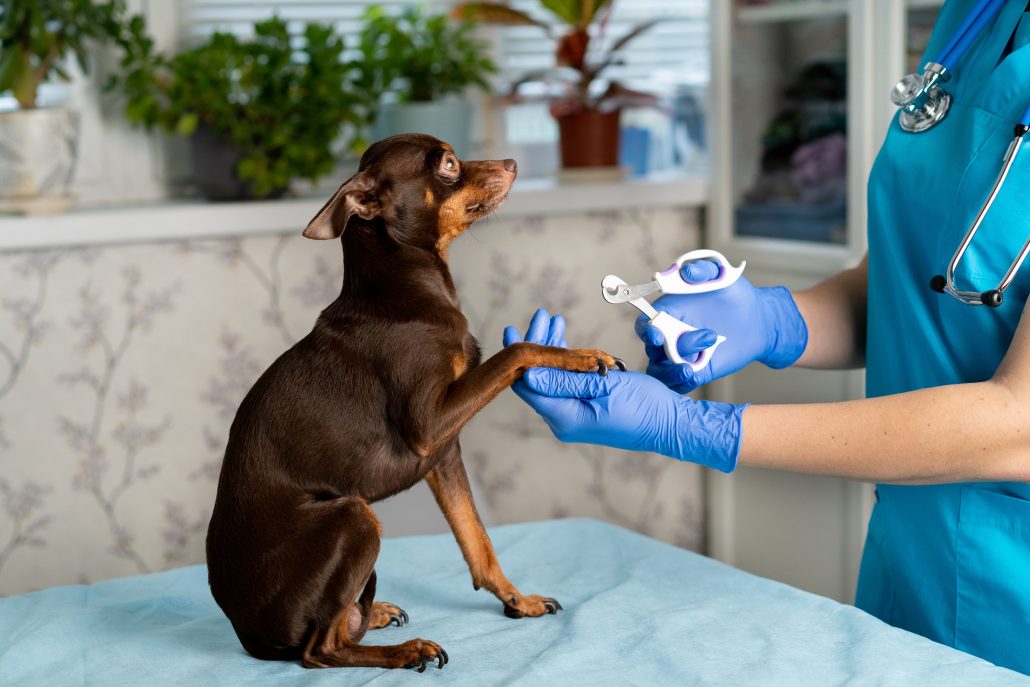
What to Do If You Cut the Quick?
Accidents can happen, even during the most careful nail trimming sessions. If you accidentally trim too far and draw blood from the quick, there’s no need to panic!
1. Act Quickly
As soon as you notice the bleeding, be sure to stop it as soon as possible. Keep some cornstarch, flour, or styptic powder on hand, as these substances work effectively to halt bleeding. Gently press the powder onto the injured area for one or two seconds to create pressure and encourage clotting.
2. Keep Your Dog Calm
Stay composed and keep your dog calm during this time. Comfort them with soothing words and gentle touches to alleviate any stress or anxiety caused by the accident.
3. Observe
Monitor the nail for any signs of further bleeding. In most cases, the bleeding should stop quickly with the help of the powder. However, if bleeding persists or you are uncertain about the extent of the injury, don’t hesitate to seek guidance from your local veterinarian.
Read More: Staying Calm in a Pet Emergency
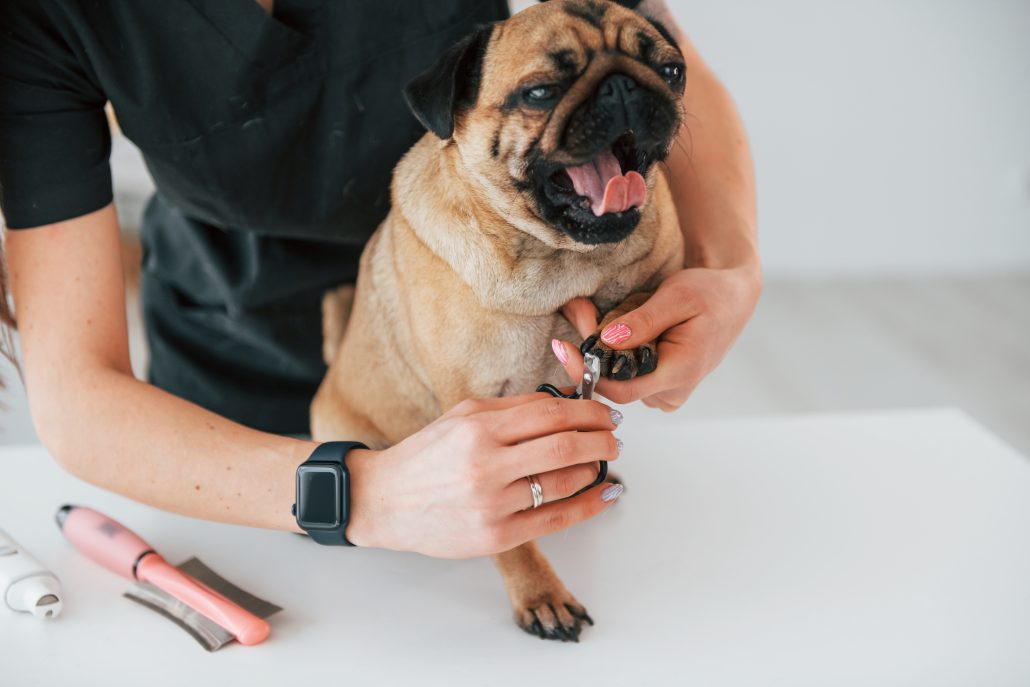
Nailing the Art of Stress-Free Nail Trims
It goes without saying that regular nail grooming is an important part of your pets care routine, and nail trimming is one crucial aspect. From understanding the significance of regular nail care to creating a positive and rewarding grooming experience, we’ve covered essential tips and techniques to ensure your pet’s paw health remains in top-notch condition.
By starting early and introducing your pet to nail trimming with patience and positive reinforcement, you can build a strong foundation of trust and comfort. Equipping yourself with the right tools, taking your time, and being cautious during the trimming process ensures a safe and enjoyable experience for both you and your loyal companion!
Whether it’s a routine nail trimming session or a more intricate medical procedure, at The House Call Vet, it is our priority is to make the experience as comfortable and positive as possible for your furry friend. We carefully assess their individual needs and tailor our approach accordingly. Get in touch with us today to learn more about our in-clinic and mobile vet services across

